
The Progressive Assurance Model – What it is and why you should use it.
Leaving the compliance and certification process until the end of a project means that risks stack up over time and problems remain unresolved or become difficult to fix.
In order to ensure successful project completion and handover, progressive assurance facilitates the management of the compliance and certification process on a continuous basis at activity level.
All projects consist of a complexity of discrete but also fully interrelated activities. A project will consist of many such activities, the more complex the project the more interrelated activities there will be.
Activities are usually defined in terms of construction process, site location and program timing. Connected activities can also be grouped together where they form a physical structure, or into larger section or zonal groupings as appropriate. Comprehensive identification and grouping of activities allows even complex projects to be mapped from earliest activities through to completion
Activities have the possibility of adversely affecting each other. For example non-conformances not closed out in an earlier activity will effect subsequent activities, when they will usually be harder and more expensive to rectify, i.e. works get covered over or made inaccessible.
Use of the progressive assurance model will provide evidence of activity compliance continuously throughout the project lifecycle.
Progressive assurance requires that the compliance of each individual defined activity is demonstrated on or as soon as possible after it is completed. In essence, each activity is assured and certified as a mini project.
Activity compliance is demonstrated by the submission of the applicable records and certification. Evidence that activity compliance has been achieved can also be formally documented by the issue of a formal completion certificate. Each of these activity certification points can be considered “Points of Assurance Certainty”, i.e. that everything in the activity is fully complete and assured.
If the progressive assurance model is followed then a structured progression of “Points of Assurance Certainty flows throughout the project. This will ensure that costs due to unresolved non-compliance and rework are minimised and that projects can be delivered right first time.
I believe that the application of the progressive assurance model is a key component to helping organisations meet the requirements of the forthcoming reformed building safety regulatory system which is the Government’s response to the ‘Building a Safer Future’ consultation.
For further information or advice on the progressive assurance model and how to implement it on a project, please contact me via LinkedIn or my website.
For further information, please see my website www.elliotconsultancyservices.co.uk or the website of Shirley Parsons Project Services www.projects.shirleyparsons.com where I am a Senior Associate.
